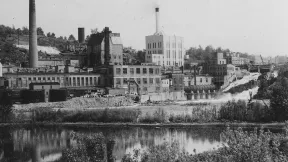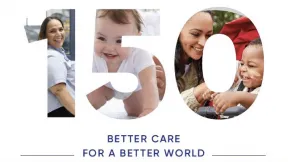Climate, Carbon, and Energy
Climate change poses multiple risks to business and society. At Kimberly-Clark, we are focused on reducing our climate emissions, while simultaneously assessing the climate-related risks that may face our business in the years to come.
Our essential brands and products rely on inputs including forest products, fossil-fuel based plastics, energy and water. Because of the potential physical and transitional risks associated with a changing climate, there could be long-term impacts to our business related to cost and supply. In addition, sustainability considerations are increasingly being incorporated as an element in customer and consumer decision-making and we believe that transitioning our business to further align with these emerging preferences provides opportunities to further our purpose of providing Better Care for a Better World with these consumers.
Kimberly-Clark is responding to relevant risks and opportunities of this moment by working to conserve energy in our operations while advancing our transition to low carbon energy sources. Factoring sustainability considerations into our energy consumption and procurement practices, renewable energy helps prepare us for rising fuel costs and/or the potential introduction of carbon pricing. Through improving our energy management and access to low carbon energy sources, Kimberly-Clark expects to realize financial savings based on actions executed beginning in 2016 and that enhance projects toward the 2030 pipeline with the goal for additional positive impact for long-term reliability of energy for our business. Our response also includes supply chain engagement to reduce our Scope 3 greenhouse gas emissions (“GHG”) and build greater climate resilience across the value chain by promoting sustainable forestry practices, reducing our reliance on fossil-fuel based materials, and increasing the use of alternative, environmentally preferred non-wood and recycled fibers.
These efforts also allow us to contribute to the objectives of UN Sustainability Development Goal 7, Affordable and Clean Energy, and Goal 13, Climate Action.
Aspiration & Goals
By 2030, reduce the carbon footprint of our products and brands:
- 50% reduction of absolute Scope 1 and 2 GHG emissions from a 2015 base year
- 20% reduction of absolute Scope 3 GHG emissions from a 2015 base year*
*Reduction target is focused on emissions from Category 1 (Purchased Goods and Services) and Category 12 (End of Life Treatment of Sold Products).
Calculation of our Scope 1 and market-based Scope 2 GHG emissions inventories is aligned with the World Resource Institute / World Business Council for Sustainable Development Greenhouse Gas Protocol (“GHG Protocol”), Corporate Accounting & Reporting Standard, revised edition. Our Scope 3 assumptions and GHG emissions calculations align with the GHG Protocol's Corporate Value Chain Accounting & Reporting Standard.
Our GHG emissions inventory is externally verified on an annual basis, through an independent accountant’s review, which provides limited assurance to the data and information included in the Statement of Energy Consumption, GHG Emissions, Water and Effluents, Waste and Health and Safety included in the GRI index.
Learn more about our climate goals and progress in our latest Global Sustainability Report.
Strategy & Approach
We are committed to aggressive, Science-based Target initiative (“SBTi”) approved GHG emissions reduction goals aligned with the Paris Climate Agreement's principal goal of limiting global temperature rise to well below 2°C above pre-industrial levels. Reducing the carbon footprint of our products and supply chain means pursuing comprehensive climate objectives across four decarbonization strategies:
1. Driving greater energy efficiency throughout our operations
2. Enacting innovative conservation efforts
3. Embracing low carbon energy supply technologies
4. Driving emissions reductions across our value chain
Driving Greater Energy Efficiency Throughout Our Operations with Lean Energy
Kimberly-Clark uses a Lean Energy strategy to drive a culture of energy conservation at our manufacturing sites. An energy management system is embedded into many of our facilities’ daily accountability processes, positioning energy efficiency at a similar level to safety, quality, delivery, and cost.
We focus on:
-
Operational systems: process improvement and standard changes to deliver efficiencies
- Management infrastructure: energy meters and dashboards to aid real-time energy management
- Mindsets, behaviors, and capabilities: improvement of training, awareness, and recognition
To elevate and continue to improve our management systems, our carbon footprint team and digital solutions team have partnered to develop integrated visual management systems, and we are exploring synergistic opportunities across various elements of sustainability—for example integrated energy and water management systems. These investments in our digital infrastructure and the capabilities of our cross-functional teams are building a strong, standardized, scalable, and aligned foundation that aligns with our plans to integrate advanced analytics with artificial intelligence to identify new energy efficiency and supply chain improvements for our facilities and products.
Enacting Innovative Conservation Efforts
Pursuing continuous improvement in both product sustainability and cost efficiency, we seek to identify and operationalize capital projects that deliver manufacturing cost savings via improved energy efficiency and reduced consumption. We aim to uncover new opportunities for innovation through energy assessments, workshops, best practices analyses, and benchmarking, in parallel with our lean energy initiatives. Examples of our process and facility energy efficiency improvements include variable frequency drives and high efficiency motors, compressed air systems upgrades, tissue machine drying system upgrades, vacuum system optimization, heat recovery systems, HVAC systems optimization, lighting retrofitting, process technology upgrades, energy supply systems optimization, steam and condensate systems upgrade, and more.
Embracing Low Carbon Energy Supply Technologies
Our carbon footprint strategy involves significant investment in renewable energy generation. Through on-site installations and power purchase agreements (PPAs), Kimberly-Clark is scaling up our solar and wind inventory to contribute toward our 2030[?] SBTi goal, drive GHG emissions reduction, and reduce our manufacturing and electricity costs.
Some of our manufacturing facilities employ cogeneration units that burn natural gas to generate electricity and reuse the waste heat to produce steam for use in the manufacturing process.
As part of our 2030 SBTi commitment, Kimberly-Clark intends to continue pursuing strategic partnerships to develop thermal decarbonization technologies and alternative fuels to power our high-thermal-load tissue facilities around the world.
Driving Emissions Reductions Across Our Value Chain
The Scope 3 categories of purchased goods and services and end-of-life treatment of sold products represent over 70% of our value chain emissions inventory. We have identified that materials and product design changes are likely required to achieve our SBTi goals.
As a first step, our global business teams are working to determine how to reduce our use of traditional, fossil-fuel based plastics while enhancing the potential of our remaining plastics to be reused or recycled. Teams are also working to increase our use of environmentally preferred fibers and have developed a forest carbon baseline and inventory by measuring the biogenic carbon of the company’s fiber mix across virgin wood fiber, recycled fiber, and sustainable alternative non-wood fibers. This will help us to make decisions and monitor progress as we shift our fiber mix to more sustainable options.
Our comprehensive Scope 3 GHG emissions reduction strategy utilizes cross-functional teams to drive action across our value chain. In the near term, we are focused on:
- Reducing our plastics footprint by 50% compared to 2019 while prioritizing alternative materials with a lower carbon impact
- Reducing our natural (Northern) forest footprint by 50% from 2011 through increasing the use of environmentally preferred fibers and investing in non-wood fiber innovation
- Engaging and partnering with our suppliers on their Scope 1 and 2 GHG emissions reduction targets and strategies to drive ongoing improvement and provide specific emission factors for our materials
- Developing improved digital capability that will continuously improve the availability and accuracy of our Scope 3 GHG emissions data
- Addressing our upstream transportation GHG emissions (Category 4) through local logistics efficiency improvements and working with outside logistics partners on renewable fuel options.
In partnership with WWF, we are currently exploring pathways for setting and achieving both near-term and long-term science-based targets (SBTs) aligned with SBTi’s Corporate Net-Zero standard, the world’s first framework for setting corporate net-zero targets in line with climate science. Kimberly-Clark’s current near-term SBTs were validated by SBTi in 2020.
Climate Change Resilience
To better communicate the potential financial implications related to our value chain’s climate risks and opportunities, we have adopted the recommendations of the Task Force on Climate-related Financial Disclosures (TCFD) and published a TCFD-aligned report using the tools and expertise provided by Willis Towers Watson. The findings we share combine results from a qualitative and quantitative assessment of Kimberly-Clark’s transition and physical climate risks and a gap analysis against TCFD’s four core areas: governance, strategy, risk management, and metrics and targets.
Through this kind of holistic assessment, we believe we are better able to align our risk management and strategic planning processes with the evolving challenges of climate change. We are seeking to improve our climate resilience in the short-term through:
- Working to identify and bring to market more sustainable alternatives to fossil-fuel based plastics and natural forest fibers
- Advancing global deployment of new renewable electricity capacity
- Partnering with material and transportation providers to drive and deliver supply chain carbon footprint reductions
- Working with local governments and alternative fuel suppliers on cost-effective solutions (including green hydrogen, RNG, electrification, and biomass) to further reduce our facilities’ reliance on natural gas
Visit our TCFD Report for more information on our climate strategy.
Published June 2024










